Contact me Go to home page Return to main travel page
Los Angeles and the Big Sur Coast
2014
*
Michael Kluckner
|
A January trip prompted by
a cheap Westjet airfare, the post-Christmas blues and the desire
to see again a part of California where I hadn't travelled since
the 1970s...
(Right) The Los Angeles I remembered was one, ironically, where cars are obligatory but invisible – the thousands of blocks lined with tall, sinuous palms and lush landscaping, the occasional tile roof visible through the shrubbery, with little traffic and few parked cars. Suburbia has rarely looked so sweet. And yet, with every activity involving a car trip, the travelling on the crowded freeways would certainly wipe out any tranquility you might attain by having a bungalow under the blue sky. No doubt I'm too much of a compact-town person to understand the appeal. Yet it was huge fun driving around on the freeways, not knowing whether it would take 15 minutes or an hour to make a journey from, say, downtown to Pasadena because of the traffic jams. LA has always been a city of houses rather than of grand buildings like a Chicago or New York, but the downtown was more interesting than I remembered and is definitely coming back to life with conversions of old buildings into condos/rentals and other construction for a new group of residents who would rather walk or take the Metro than drive. •Here are some snapshots with the cellphone camera of Los Angeles architecture (which opens as a pop-up on a computer and a separate page on a tablet or phone). •Once we got out on the coast it became a great trip for watercolours and other doodlings of the long views and long winter shadows – scroll down the page to see them ... •And, at the bottom, I've put a section on bungalow courts, that distinctive style of Southern California housing I wish would be reintroduced into cities like Vancouver. |
The Gamble House in Pasadena |
Here's the route we took...
| Morro Bay, where we overnighted on our way
north, is the most tranquil and affordable of the coastal
places. A few blocks of motels and cottages ring a lagoon with a
distinctive volcanic lump of rock providing an explanation
point; along the shore are a range of restaurants and taverns
plus the usual tourist-souvenir sorts of places, a scene of
wharves and boats, gulls and otters. All very appealing. The sunset was too beautiful to be ignored by my paintbox, which normally has an aversion to that level of kitsch. The raft with the three poles near the centre was home to dozens of sea lions, whose cheerful barking serenaded the harbour as I worked. |
| North of Morro Bay, arid California creeps
to the very edge of the Pacific Ocean. Water, water everywhere
but nary a drop to drink, as Coleridge wrote. Los Angeles had 3 inches of rain in 2013 instead of its usual 15. The landscape was blasted to a brown colour, and only the plundering of the State's aquifers kept its agriculture productive. During the time we were there, LA had temperatures in the high 80s rather than the 68 which is their normal January average. A stubborn brush fire in the northeast part of the LA region took days to put out, and Governor Jerry Brown declared a state of emergency. Just one of their regular drought cycles, like the one in the 1970s, or evidence of climate change ... ? |
| January at Puertas Blancas is both calving
season and mating season, an extreme example of female
oppression, perhaps. The sight of a thousand elephant seals, a
dozen feet long and wobbly like hot-water bottles or jello
sausages, skidding around on the sand, snoozing, fighting,
feeding, and flipping sand onto themselves and their neighbours,
all observed by a thousand tourists (some of whom can be seen in
the extreme top left corner) is not one we will soon forget. How there can be a fish left in the sea to supply California's sushi restaurants is a mystery, what with these behemoths and the sea lions, harbour seals and otters that thrive in every bay and lagoon. |
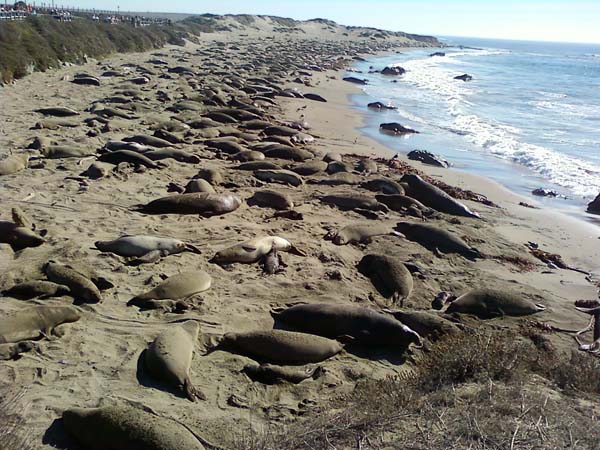 |
|
(Above) Lucia Lodge on Highway 1
is a collection of cottages built in the 1930s by the Harlan
family, who settled along the Big Sur coast in the 19th
century. According to its website, it is in the 5th generation
of family ownership.
What struck me was the compositional similarity involving one of the cottages, the one closest to the cliff edge, to a painting of Claude Monet's ... "Customs Officer's House at Varengeville." (Right) the coast at Esalen on Big
Sur. There was a spot to pull over and, while I started the
watercolour, we chatted with a photographer whose camera,
mounted on a tripod, had a lens about as long as my leg. He
was photographing the annual migration of grey whales, and as
we sat there a pod slipped by, their spouts easily visible to
the naked eye.
One distinctive feature of the coast is the salt spray from the surf which places a pale blurry line along the distant headlands above the beach. (In watercolour, paint on damp paper and then gently sponge the colour away.) |
A lagoon with a population of gulls not far south of Big
Sur Station. The stunning thing about the coastline, perhaps
unique to a drought year like this one, was the red colour of
this succulent, which is a pretty common coastal ground-covering
all over the world but is usually a blue-green colour. Anybody
know its name? 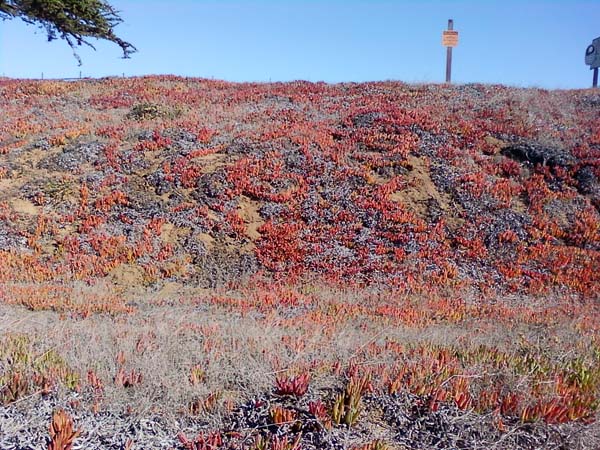 |
A different type of painter at work in Monterey Bay
Ploughed winter fields south of Salinas in the curious misty winter light that might be dust or ...?
Bungalow Courts
| According to Wikipedia, the bungalow court was invented in
Pasadena in 1909 and was the predominant form of multi-family
housing in Southern California until the 1940s. The idea is to
arrange several small houses around a central green – often they
are 3 units of row housing forming a 'U'. Another Wikipedia entry
references a court in Des Moines, Iowa – the only example in that
city. A good article describing the history of bungalow courts and
focusing on San Diego is at this
link. [There were a number of them in Vancouver, British Columbia, the most venerable being Tatlow Court on Bayswater Street near English Bay in Kitsilano: 12 one-bedroom units in steep-roofed Tudor cottages (a Leonard Frank photograph from 1933). Others, much more modest, were dotted along
Fourth Avenue and Broadway, built probably by the Central
Mortgage & Housing Corporation immediately after the
Second World War, and have been demolished for more 'ordinary'
multi-family apartment/condo buildings. Part of my interest in
them is my desire to reintroduce them into the Vancouver
housing mix, because they offer a combination of shared
grounds, opportunities for children's play and gardening,
small affordable units (maybe) and relatively low impact on
neighbours.]
The court below in Santa Monica, across the street from the Resthaven Motel where we spent a night, caught my eye.... |
I've eliminated most of the landscaping, as in reality it looked like this ...
... and the units had back doors opening onto a 3-foot walkway along the property edges.
Other courts I spotted along the way (they're hard to photograph):
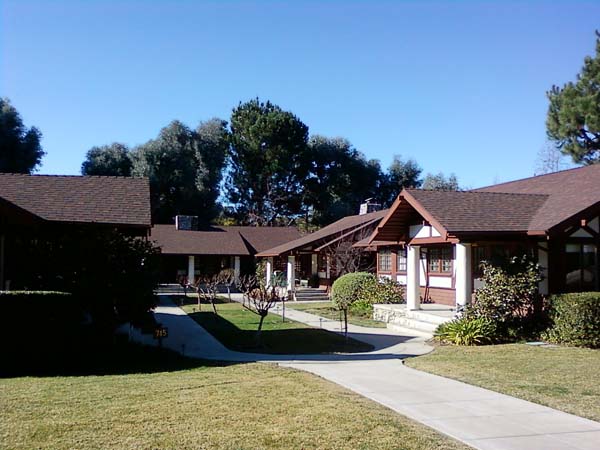
A posh one in Pasadena...
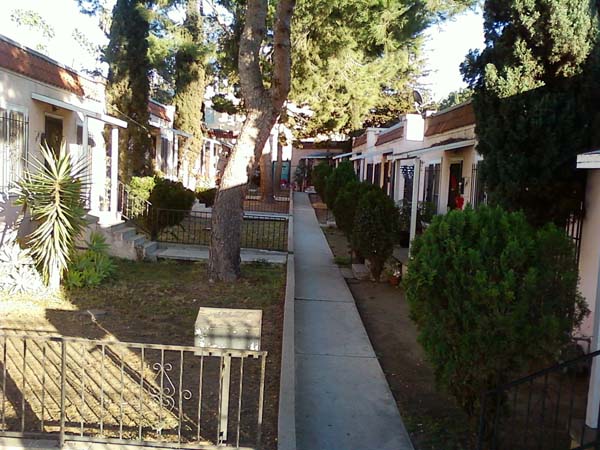
A Spanish Colonial one on Western Avenue in Hollywood ...
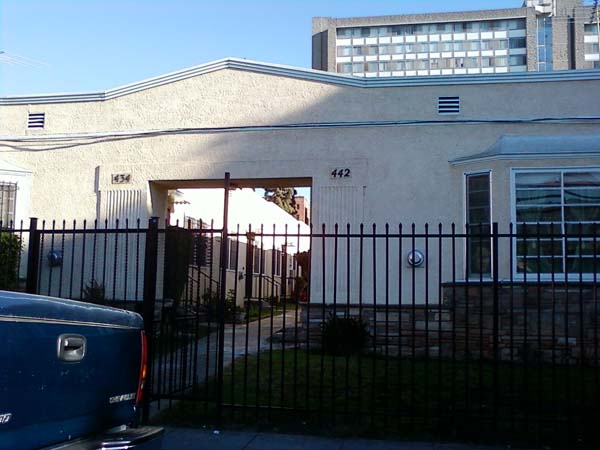
A Deco one in a very poor neighbourhood on Burlington Street in Macarthur Park East...
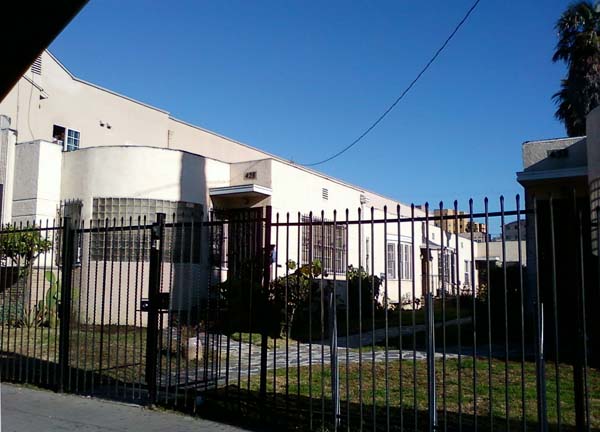
... and its Streamline Moderne neighbour. The gates obviously indicate the security concerns for the residents in parts of LA.
Contact me Go to home page Return to main travel page
Artwork & text © Michael Kluckner, 2014